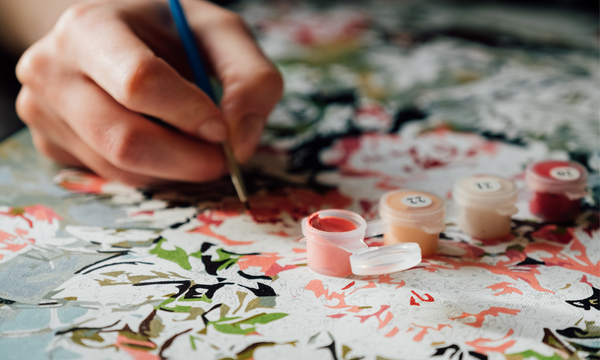Achieve professional-level painting results by applying a variety of acrylic painting techniques to your paint-by-numbers!

Acrylic paint, known for its quick drying time, is a water-based medium. It offers versatility, allowing for different application methods ranging from delicate washes to thicker layers. Additionally, it can be combined with other mediums to create diverse textures and effects.
Enhance the realism of your paint by numbers artwork with the following techniques: The ones you choose to use will depend on your unique painting style and desired artistic effect. Don't hesitate to experiment with various techniques to find the ones that best suit your paint by numbers style.
Let's start with a commonly asked question when beginning acrylic painting:
Should you use water or paint directly from the pot?

Water can be added to acrylic paint to increase its fluidity, making it easier to work with. This can be particularly helpful for beginners who are still honing their brush control skills. Using water can also create a more translucent effect, allowing the underlying layers to shine through. However, it's essential to avoid excessive water as it may dilute the paint excessively, making it challenging to achieve vibrant colors and complete coverage of the numbered areas on your canvas.
On the other hand, using undiluted acrylic paint directly from the pot produces an opaque effect with vivid colors. This technique is particularly useful for creating textured effects where the paint is applied thickly and allowed to dry in layers. Please note that thicker layers of paint will definitely more effectively cover the numbered areas on your paint by numbers canvas.
THE BLENDING TECHNIQUE FOR GRADIENTS AND TRANSITION EFFECTS
The blending technique involves seamlessly merging two colors to create smooth and gradual transitions.

There are two primary blending methods in acrylic painting that you can apply when creating your paint by numbers: wet-on-wet blending and dry-on-wet blending.
Wet-on-Wet Blending
To achieve this effect, apply a line of color on each side of the area where you want to create a gradient effect. Then, use a dry brush to blend the colors back and forth. This technique produces a soft and subtle gradient effect that can be used to create seamless transitions between colors.
Dry-on-Wet Blending
For this method, apply two different colors side by side. Then, use a wet brush to blend the colors together. This can be done using circular motions or a sweeping motion. This technique creates a smoother and more uniform gradient effect.
The blending technique in acrylic painting is beneficial for a variety of painting projects. It can be used to create soft backgrounds, color gradients, light and shadow effects, or simply to add texture and depth to your artwork.
By using blending techniques, you can also achieve light and shadow effects in your artwork. For example, you can use a lighter color to create a smooth transition between bright and shaded areas, giving your painting a sense of depth and realism.
You can also create a gradient effect using a sponge. First, apply the base color to your canvas, then dip a sponge into the color you want for the gradient. Stamp the sponge on the canvas, creating a line of color. Next, dab the area between the base color and the line of color you created. This technique produces a soft and subtle gradient effect that can be used for delicate color transitions.
THE "LAYERING" TECHNIQUE
The layering technique is a commonly used method in acrylic painting to add depth, texture, and complexity to any artwork. It involves applying multiple layers of paint that will create unique visual effects on your paint by numbers.

Simply apply a layer of paint, allowing it to dry completely, before adding a new layer with different colors. Repeat this process as needed to achieve the desired effect.
One of the primary purposes of using the layering technique is to create shadows and reflections. By layering different colors, you can achieve deeper tones and subtle shades. For instance, to create a shadow, apply a layer of dark paint and then add successive layers of lighter colors to create a gradient effect.
It's crucial to ensure that each layer of paint dries completely before applying a new one. Applying paint to a wet layer can result in smudges and blotches on your artwork.
THE "GLAZING" TECHNIQUE
The glazing technique involves applying a thin layer of transparent paint over a dry layer of paint to create light and depth effects.
To create a glaze, dilute your acrylic paint with water or a transparent acrylic medium. Apply a thin layer of diluted paint over a dry layer of paint. You can repeat this process with multiple glaze layers as necessary to achieve the desired effect.
Glazes can be used to create various effects, including shadows, reflections, and light effects. By using translucent glaze layers, you can achieve depth and transparency effects that are difficult to attain with other acrylic painting techniques.
Glazes can also intensify colors or create subtle variations. Applying a complementary glaze layer over a dry layer of paint can enhance brightness and intensity, surpassing what a single layer of paint can achieve.
Make sure to let each glaze layer dry completely before adding a new layer.
THE "IMPASTO" TECHNIQUE
The impasto technique involves applying thick paint to create texture and relief effects in your paint by numbers artwork.

Impastos are created using a wide, thick brush loaded with a generous amount of acrylic paint. Apply the paint to the canvas using short, quick brushstrokes, resulting in a rough surface texture. Impastos are often used to infuse movement into artwork or create interesting surface textures.
This technique is suitable for various paint by numbers projects, including landscapes, still life, and portraits. Impastos can be used to create light and shadow effects, add depth and texture to landscapes, or depict material effects in still life paintings. Additionally, they can add dimension to portraits by creating intriguing surface textures. Used alone or in combination with other acrylic painting techniques, impastos will help you achieve a wide range of visual effects. For example, they can be combined with glazes to create subtle light effects or blended with blending techniques for smooth color transitions.
The choice of colors for impastos depends on the project and desired effect. Warm colors can convey movement and warmth, while cool colors can create a calmer and more serene atmosphere. Bright and vibrant colors are effective for light and shadow effects, while darker hues can establish a sense of depth and mystery.
Now, it's time for you to explore the world of acrylic painting techniques! Figured'Art will guide you throughout the entire paint-by-numbers process. Remember, while it's an activity meant to be relaxing, why not challenge yourself to improve your technique with each painting?
Have you selected your next Figured'Art adult paint by numbers kit? It's time to get serious and start painting!


